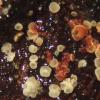
09-12-2025 12:06
 Andgelo Mombert
Andgelo Mombert
Bonjour,Je recherche l'article concernant Hypobryo

07-12-2025 16:07
Arnold BüschlenHallo, ich habe in einer Moos-Aufsammlung (epiphy

08-12-2025 21:04
Mark Stevens"Hello everyone,I'm relatively new to microscopy (

08-12-2025 18:59
 Lothar Krieglsteiner
Lothar Krieglsteiner
.. found by a seminar-participant, I do not know t

08-12-2025 17:37
 Lothar Krieglsteiner
Lothar Krieglsteiner
20.6.25, on branch of Abies infected and thickened

16-03-2014 22:00
Hello,I found this species a few months ago but ha

08-12-2025 13:39
Thomas Læssøehttps://svampe.databasen.org/observations/10572899
Calycina conorum
Yannick Mourgues,
01-02-2008 23:49
 Bonsoir.
Bonsoir.J'ai observé que Calycina conorum rougissait fortement à la blessure. Est-ce que l'un d'entre vous saurait pourquoi ? Quelle est la réaction chimique responsable de cela ?
I have watched that Calycina conorum becomes strongly reddening when hurted. Do you know why ? What is the chemical process ?
Merci par avance.
Yannick
Perz Piotr,
02-02-2008 09:39
Re:Calycina conorum
Hi Yannick
I thint this is oxidation of VBs i paraphyses, marginal- & excipulum cells.
Pimpek
I thint this is oxidation of VBs i paraphyses, marginal- & excipulum cells.
Pimpek
Hans-Otto Baral,
02-02-2008 11:38

Re:Calycina conorum
Yes, it is a wide-spread property in Helotiales and always the result of oxidation of refractive vacuoles. Typical of Lachnum, Bryoscyphus, some of Calycina etc. I think it has to do with benzol rings in which the double bindings change through oxidation and therefore get coloured. It is always a lethal process so that redbrown paraphysis or hair cells are never coloured as long as they are alive.
We have so important vital characters like VBs and we know so little about thier chemical background. It would be an interesting field of research for chemistry.
Zotto
We have so important vital characters like VBs and we know so little about thier chemical background. It would be an interesting field of research for chemistry.
Zotto

